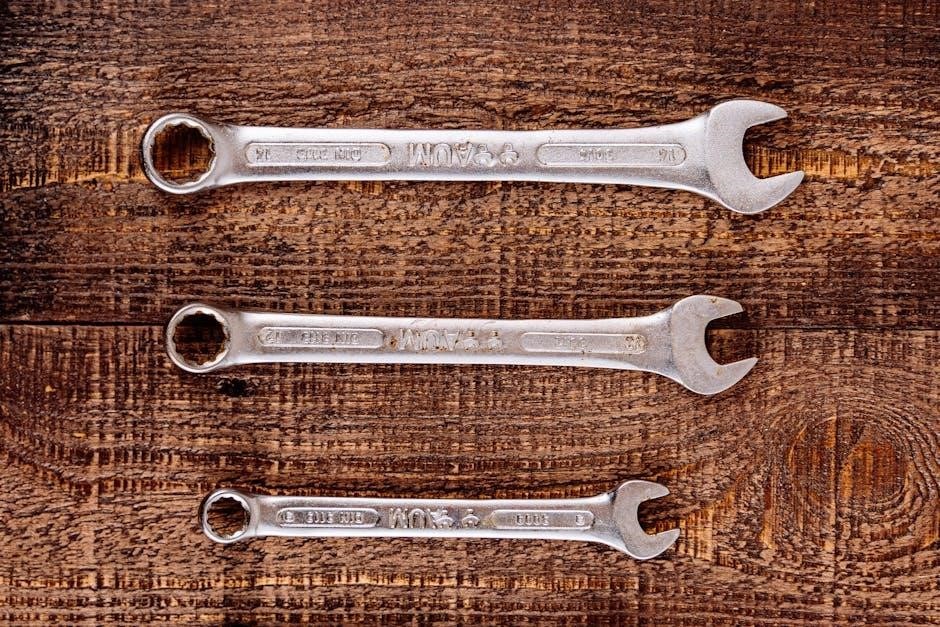Craftsman Garage Door Opener Instruction Manual: A Comprehensive Guide
Welcome to a comprehensive guide designed to help you navigate your Craftsman garage door opener manual. This resource provides essential information for safe operation, installation, and troubleshooting. Follow the instructions carefully for optimal performance and longevity of your device.
Craftsman garage door openers are renowned for their reliability and durability, offering homeowners a convenient and secure way to access their garages. This introduction provides an overview of Craftsman openers, highlighting their key features and benefits. Understanding the basics of your Craftsman opener is crucial for proper installation, safe operation, and effective maintenance. Craftsman openers often come with various features, including safety sensors, remote controls, and smartphone connectivity, depending on the model. Familiarizing yourself with these features will enhance your user experience and ensure the safe operation of your garage door. Before proceeding with installation or operation, it is essential to consult the specific instruction manual that accompanies your Craftsman garage door opener. The manual contains detailed information about your model, including safety guidelines, installation procedures, and troubleshooting tips. This guide serves as a supplementary resource, providing general information and guidance, but it should not replace the official Craftsman manual. Whether you are a first-time user or an experienced homeowner, understanding the fundamentals of Craftsman garage door openers will empower you to maintain and operate your garage door safely and efficiently. Remember to always prioritize safety and consult the manual for specific instructions related to your model.
Safety Rules and Operating Instructions
Prioritizing safety is paramount when operating a Craftsman garage door opener. Always read and adhere to all safety rules outlined in the instruction manual before initial use. Familiarize yourself with the opener’s functions, including the emergency release mechanism, and ensure all household members understand how to use it. Regularly inspect the garage door and opener for any signs of damage or wear. Never allow children to play near the garage door or operate the opener without adult supervision. Perform monthly tests of the safety reversal system by placing an object in the door’s path. The door should automatically reverse upon contact. If it doesn’t, consult the troubleshooting section of your manual or contact a qualified technician. Ensure the safety sensors are properly aligned and free from obstructions. These sensors prevent the door from closing if an object is detected in its path. Never disable or bypass these safety features. When operating the opener remotely, always maintain a clear line of sight to the garage door. Avoid operating the opener if anyone is near the door. Store remote controls out of reach of children and consider using a keypad with a temporary PIN for added security. By following these safety rules and operating instructions, you can ensure the safe and reliable operation of your Craftsman garage door opener.
Installation Guide for Sectional Doors
Installing a Craftsman garage door opener with a sectional door requires careful attention to detail. Before beginning, consult your specific model’s instruction manual for precise measurements and component identification. Begin by ensuring the door operates smoothly and is properly balanced. A poorly balanced door can cause excessive strain on the opener, leading to premature failure. Next, assemble the rail according to the instructions, ensuring all components are securely fastened. Attach the rail to the header bracket above the door, making sure it is level and securely mounted. Connect the opener motor to the rail assembly. Attach the door bracket to the top panel of the sectional door, reinforcing the area if necessary. Connect the door arm to both the door bracket and the trolley on the rail. Adjust the travel limits of the opener to prevent the door from over-traveling in either direction. These adjustments are crucial for safety and optimal performance. Install the safety sensors near the bottom of the door, ensuring they are properly aligned and facing each other. Test the safety reversal system by placing an obstruction in the door’s path. The door should automatically reverse upon contact. Finally, connect the opener to a grounded electrical outlet and test all functions, including the remote control and wall-mounted button. Consult the troubleshooting section if any issues arise during installation.

Installation Guide for One-Piece Doors
Installing a Craftsman garage door opener for a one-piece door differs significantly from sectional door installations. Begin by verifying the door’s smooth, balanced operation. Imbalances can overload the opener. Consult the manual for model-specific instructions and component identification. Assemble the rail assembly per the manual, ensuring secure connections. Mounting the header bracket above the door is crucial; ensure it’s level and firmly attached to a structural support. Attach the opener motor to the rail. The door bracket, designed for one-piece doors, must be securely fastened to the door’s frame, often requiring reinforcement. Connect the door arm between the trolley on the rail and the door bracket. This connection’s geometry is critical for proper operation. Adjust the travel limits meticulously to prevent over-extension or retraction, safeguarding the door and opener. Install safety sensors, if applicable, though some one-piece door setups may not accommodate them. Test the safety reversal system, if installed, to ensure it functions correctly upon obstruction. Connect the opener to a grounded power source, adhering to electrical safety codes. Thoroughly test all functions, including remote control and wall button operation. If encountering issues, consult the troubleshooting section of the manual. Remember, precise adherence to the manual is vital for safe and effective installation of a Craftsman garage door opener with a one-piece door.
Tools Required for Installation and Adjustment
Successfully installing and adjusting a Craftsman garage door opener necessitates having the correct tools readily available. A comprehensive toolkit ensures efficiency and safety throughout the process. Essential hand tools include adjustable wrenches, various screwdrivers (both Phillips head and flathead), pliers, and a socket set. A measuring tape is crucial for accurate placement and alignment of components. A level, ideally a spirit level, is vital for ensuring the header bracket and rail are perfectly horizontal. Power tools, such as a drill with assorted drill bits, will expedite tasks like fastening brackets and mounting hardware to wood or metal. A hammer is useful for tapping components into place. Wire strippers and crimpers are necessary for electrical connections, ensuring secure and safe wiring. For adjusting the door’s balance, winding bars are required to safely manage torsion springs (if applicable). Eye protection, such as safety glasses, is paramount to protect against debris. Work gloves improve grip and protect hands. A sturdy ladder is essential for reaching overhead areas. Finally, a voltage tester confirms power is off before working with electrical components. Having these tools will make the installation and adjustment of your Craftsman garage door opener smoother and safer, ultimately leading to a properly functioning system.
Assembly and Adjustment Procedures

The assembly and adjustment phases are crucial for ensuring your Craftsman garage door opener operates smoothly and safely. Begin by carefully assembling the rail sections, ensuring they are securely connected according to the manual’s instructions. Next, attach the opener motor unit to the assembled rail, paying close attention to the alignment and securing it with the provided hardware. Once the rail is mounted, install the trolley assembly, which connects the opener to the door. Ensure the trolley moves freely along the rail. Next, connect the door arm to the trolley and the garage door itself, ensuring a solid and reliable connection.
Adjustment is key to proper operation. Adjust the travel limits, which determine how far the door opens and closes, preventing damage to the door or opener. This typically involves adjusting screws or dials on the motor unit. Next, adjust the force settings, which control the amount of power the opener applies to move the door; Too much force can be dangerous, while too little may prevent the door from closing completely. Test the safety reversal system, ensuring the door reverses direction when it encounters an obstruction. These careful adjustments are critical for the safe and reliable operation of your Craftsman garage door opener.
Wiring Diagram and Electrical Connections
Understanding the wiring diagram and electrical connections is essential for safely and correctly installing your Craftsman garage door opener. The wiring diagram provides a visual representation of how the various electrical components are connected, including the motor, safety sensors, wall control, and any optional accessories. Before commencing any electrical work, always disconnect the power supply to the garage door opener at the circuit breaker to prevent electrical shock.
Carefully examine the wiring diagram to identify the terminals for each component. Typically, the motor will have connections for power, neutral, and ground. The safety sensors, which are crucial for preventing the door from closing on obstructions, will have their own dedicated terminals. The wall control, which allows you to operate the door from inside the garage, will also have specific connections. When connecting the wires, ensure they are securely attached to the terminals and that there are no loose strands. Use appropriately sized wire connectors to ensure a reliable connection. Double-check all connections against the wiring diagram before restoring power to the opener. If you are uncomfortable working with electricity, consult a qualified electrician to perform the wiring.
Warranty Information and Service Availability
Your Craftsman garage door opener comes with a warranty that protects against manufacturing defects and component failures. The warranty period typically varies depending on the specific model and can range from one year to a limited lifetime warranty on certain parts, such as the motor. To ensure your warranty remains valid, it is essential to register your garage door opener with Craftsman shortly after purchase. This registration process usually requires you to provide your name, address, purchase date, and the model number of your opener.
The warranty covers repairs or replacements of defective parts, but it typically does not cover damage caused by improper installation, misuse, neglect, or normal wear and tear. If you experience a problem with your garage door opener during the warranty period, contact Craftsman customer service to initiate a warranty claim. You may be required to provide proof of purchase and a description of the issue. Depending on the nature of the problem, Craftsman may offer on-site repair services or instruct you to ship the opener to an authorized service center. Be sure to retain all documentation related to your warranty claim. If you are unable to resolve the issue through warranty, you can also seek assistance from local garage door repair professionals.

Troubleshooting Common Issues
Encountering issues with your Craftsman garage door opener can be frustrating, but many problems can be resolved with simple troubleshooting steps. One common issue is the door failing to open or close completely. First, check the safety sensors located near the bottom of the door tracks. Ensure they are aligned and free from obstructions, as misaligned or blocked sensors can prevent the door from operating. Another frequent problem is a malfunctioning remote control. Try replacing the batteries in the remote and reprogramming it to the opener. If the opener still doesn’t respond, the issue might be with the receiver unit on the opener itself.
If the garage door opener makes a grinding noise, inspect the trolley, chain, or belt for wear or damage. Lubricate these components regularly to ensure smooth operation. A door that reverses unexpectedly during closing could indicate a problem with the force settings. Adjust these settings according to the manual to ensure the door closes with adequate force but reverses if it encounters an obstruction. If none of these steps resolve the issue, consult a qualified technician for further assistance. Remember to disconnect the power before attempting any repairs.

Locating and Downloading Manuals
Finding the correct Craftsman garage door opener manual is crucial for safe and effective operation, maintenance, and troubleshooting. Several resources are available to help you locate and download the specific manual for your model. Start by checking the Craftsman website, where a comprehensive library of manuals is often available. You can typically search using your model number, which is usually found on the opener unit itself.
If you cannot find the manual on the Craftsman website, try searching online using the model number and keywords like “Craftsman garage door opener manual PDF.” Many third-party websites and online retailers also host manuals for various models. Be cautious when downloading from unofficial sources, ensuring the site is reputable and the file is safe from malware. Another option is to check online forums and communities dedicated to garage door openers. Users often share manuals and offer advice on where to find specific documents. Remember to save the downloaded manual to your computer or device for easy access in the future. Having a readily available manual can save time and prevent potential issues.